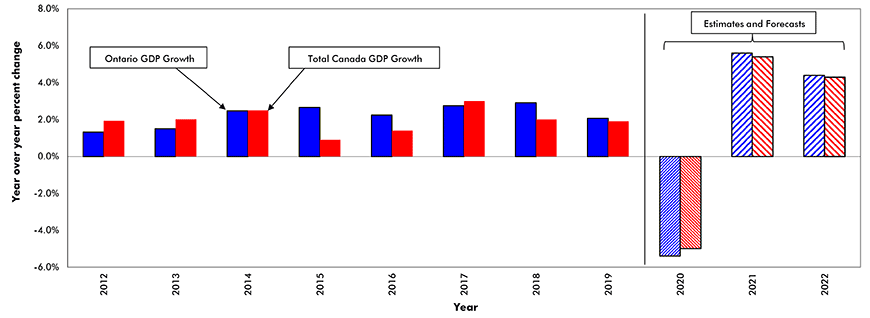With record new cases of COVID-19 leading the government to adopt measures to limit the spread of the virus to almost the same degree of harshness as in March of last year, there is a real risk that the recently announced lockdowns will cause growth to stall in the first quarter of 2021. This prospect is exacerbated by the federal government’s recent announcement that its already glacial pace of vaccine delivery will be further interrupted due to production problems at Pfizer-BioNTech’s drug-making plant in Belgium. While this unexpected glitch in vaccine distribution does not extinguish the light at the end of the tunnel referred to in my recent Snapshot, COVID-19 Vaccine Gives Big Boost to Global and National Outlook, it certainly extends the length of the tunnel.
While the current wave of COVID is hitting the province and its major trading partners harder than earlier waves, in terms of hospitalizations and case counts, its impacts on the province’s exports are likely to be smaller given that both foreign and domestic governments have income support programs in place and companies have acquired experience in managing their staff members remotely.
Looking beyond the first quarter of this year, the outlook for the economy brightens considerably due to the simultaneous positive impacts of increased vaccine distribution on economic activity in the United States (the market for three-quarters of the province’s exports) and on consumer spending and business investment within the province.
President Joe Biden’s fiscal stimulus package is unlikely to have an immediate positive impact on the U.S. economy. That said, some robust forward-looking indicators, including the Manufacturing and Services PMIs, together with the University of Michigan’s Consumer Sentiment Index, suggest that U.S. economic strength will underpin the growth of Ontario’s manufacturing exports through the second half of 2021 and into 2022.
Although employment retreated slightly in December and the most recent labour stats have yet to reflect the impact of the January lockdown, the province has clawed back 76% of the jobs it lost as a result of the first COVID infection wave in March 2020. Across industries, hiring by firms in the accommodation and food services industry is up by +47% since February 2020. Solid jobs gains have also been recorded by manufacturing (+26%), information services (+20%), and construction (18%).
Driven by the combination of elevated pent-up demand, the above-noted rebound in hiring, government income support programs, a big jump in personal savings and a steady rise in consumer confidence, Ontario retail sales are ahead by +60% since April 2020. This increase, second only to Quebec’s gain, has been in large part caused by a surge in sales of motor vehicles, building materials, clothing, and home furnishings.
Just as it did in March of last year, the current lockdown will depress consumer spending in the first quarter of this year. However, the combination of a vaccine-fueled rebound in confidence and increased pent-up demand will provide a boost during the remainder of the year.
Against the headwind of measures to limit the spread of COVID-19 and a pronounced slowdown in permanent migration, sales of existing homes in the second half of 2020 shot up by 30% compared to the same period a year earlier. The key drivers of this surge in housing demand were extremely low-interest rates, a sharp rise in savings and a pronounced increase in the number of first-time buyers seeking more affordable single-family homes on the less-dense fringes of the province’s larger census metro areas.
Looking forward, the pronounced drop in condo rental activity in the Greater Toronto Area suggests single-family house construction will outpace multiple-unit ground-breaking throughout most of this year and into 2022. Heading into 2022, we expect the combination of climbing prices, higher interest rates and a slowdown in net migration will dampen home sales and lead to a slower pace of new residential construction.
In contrast to the relatively strong pattern of residential construction, non-residential investment in Ontario, in the second half of 2020, was down by about -6%. This decline was very close to projection released in August of 2020. Spending in all of 2020, versus 2019, has been revised down from +4.1% to -6.5% due to the partial lockdown of much of the province’s non-residential construction sector in March of last year. Although the province is likely to operate with significant excess capacity in the near term, based on the Bank of Canada’s most recent , non-res investment should exhibit moderate growth later this year and into 2022.
After posting growth of +2.1% in 2019, we estimate that the depressing impact of COVID caused Ontario’s economy to contract by -5% to -6% in 2020. However, a vaccine-spurred increase in consumer spending, business investment and exports will combine to cause the province to expand by +5% to +6% this year and by +4% to +5% in 2022.
John Clinkard has over 35 years’ experience as an economist in international, national and regional research and analysis with leading financial institutions and media outlets in Canada.
Real* Gross Domestic Product (GDP) Growth — Ontario vs Canada



Recent Comments
comments for this post are closed